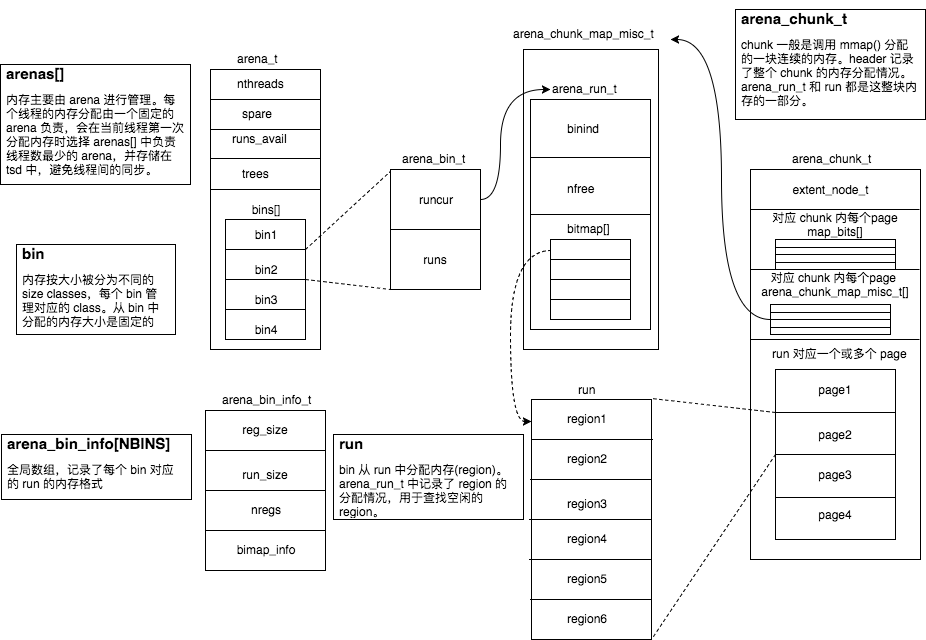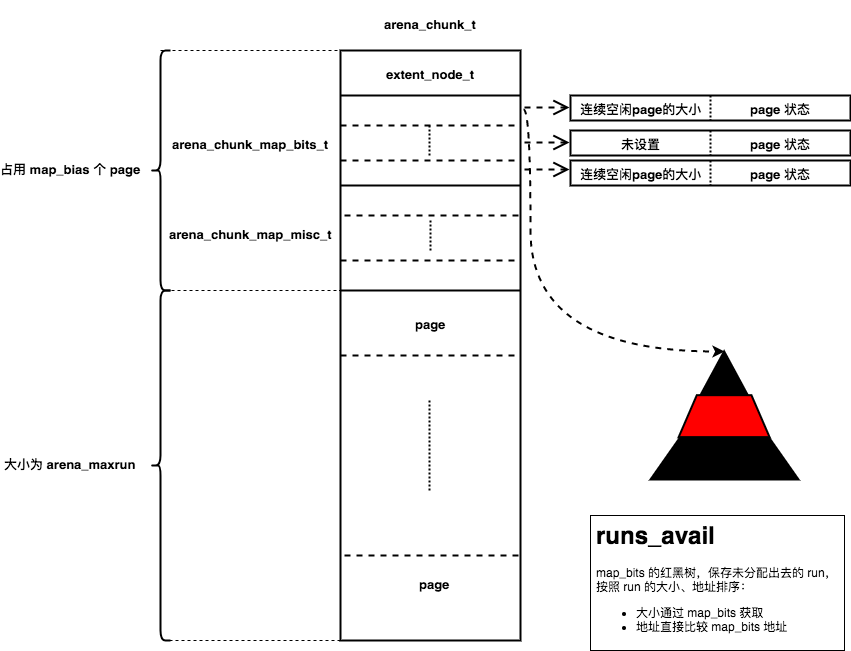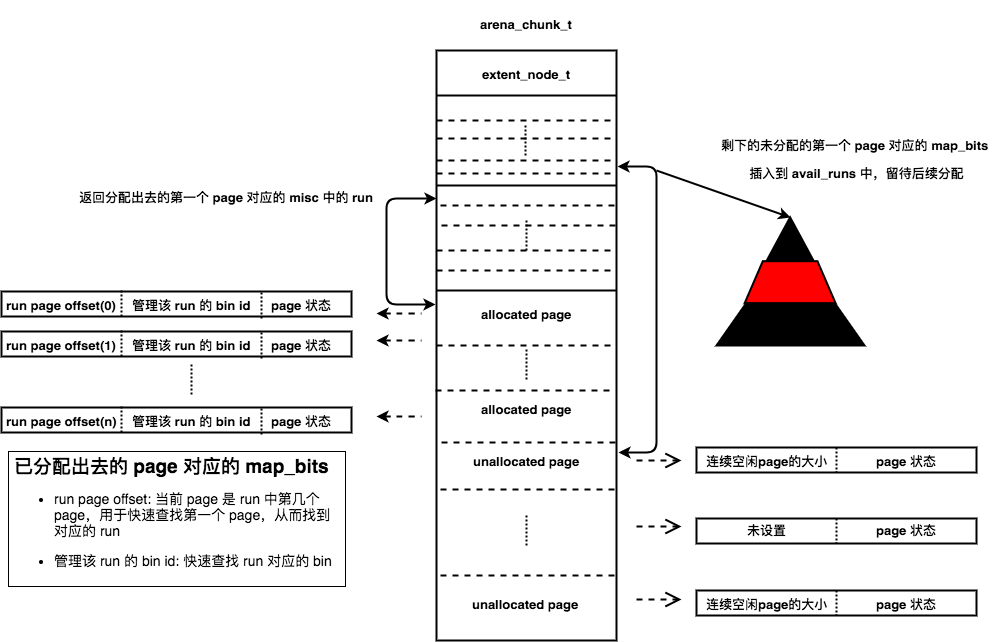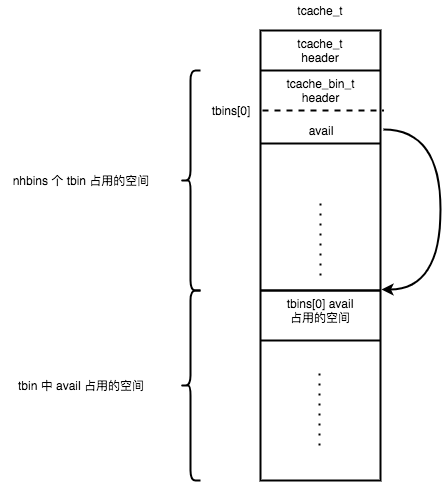转自:https://youjiali1995.github.io/allocator/jemalloc/
jemalloc 是一个通用的 malloc(3) 实现,着重于减少内存碎片和提高并发性能,在许多项目中都有用到,比如Rust 和 Redis。因为在做 Redis 相关的工作,就看了一下源码,记录一下。
一、背景知识
内存的来源
关于 Linux 中虚拟内存管理和进程地址空间就不再赘述了,可以查看我之前的笔记。
Linux 提供了几个系统调用用于分配内存:
brk(): 调整program break,改变data segment的大小。mmap(): 在进程的虚拟地址空间中创建新的内存映射。内存分配器一般使用该系统调用创建私有匿名映射分配内存,内核会以page size大小倍数来分配,page size一般为4096字节。
对应的释放内存也有几种方式:
brk(): 既可以增大也可以缩小。munmap(): 解除映射。madvise(): 该系统调用会告诉操作系统这块内存之后会如何使用,由操作系统进行处理。释放时,会使用MADV_DONTNEED或MADV_FREE:
- snippet.c
MADV_DONTNEED Do not expect access in the near future. (For the time being, the application is finished with the given range, so the kernel can free resources associated with it.) After a successful MADV_DONTNEED operation, the semantics of memory access in the specified region are changed: subsequent accesses of pages in the range will succeed, but will result in either repopulating the memory contents from the up-to-date contents of the underlying mapped file (for shared file mappings, shared anonymous mappings, and shmem-based techniques such as System V shared memory segments) or zero- fill-on-demand pages for anonymous private mappings. Note that, when applied to shared mappings, MADV_DONTNEED might not lead to immediate freeing of the pages in the range. The kernel is free to delay freeing the pages until an appropriate moment. The resident set size (RSS) of the calling process will be immediately reduced however. MADV_DONTNEED cannot be applied to locked pages, Huge TLB pages, or VM_PFNMAP pages. (Pages marked with the kernel- internal VM_PFNMAP flag are special memory areas that are not managed by the virtual memory subsystem. Such pages are typically created by device drivers that map the pages into user space.)
可以看出来,对于私有匿名映射会立即释放,而在之后再次访问这块内存时,不需要重新分配。
False cache line sharing
为了减少存储器访问延迟,CPU 中会有本地 Cache,Cache 被划分为 cache line,大小一般为 64B。CPU 访问内存时,会首先将内存缓存在 cache line 中。 在多处理器系统中,每个 CPU 都有自己的本地 Cache,会导致数据多副本,也就带来了一致性问题:多个 CPU 的 cache line 中有相同地址的内存。需要实现 Cache Coherence Protocol 来解决 这个问题。现代处理器一般使用 MESI 协议实现 Cache Coherence,这会带来通讯耗时、总线压力、导致 cache line 的抖动,影响性能。
避免这个问题主要有下面几个方法:
__declspec (align(64)): 变量起始地址按cache line对齐- 当使用数组或结构体时,不仅需要起始地址对齐,还需要
padding,使得数组元素或结构体大小为cache line倍数 - 避免多线程使用相近地址的内存,多使用局部变量
内存着色
现代 CPU 的 Cache 映射策略有很多,如组相联、全相联、直接相联。不同地址的内存有可能映射到相同的 cache line(主要发生在地址对齐的情况,如不同对象的地址按照 page size 对齐),如果频繁交替访问映射到相同 cache line 的内存,就会造成 cache line 的颠簸。 内存着色通过给对象地址增加 cache line 大小倍数的偏移,从而映射到不同的 cache line,来避免上面的问题。
为什么需要内存分配器
因为 mmap() 按照 page size 进行分配,一般是 4096 字节,若每次分配时都调用一次会造成极大的内存浪费,并且性能不好。若由程序员自己管理 page ,容易出错且性能不好,所以 glibc 中提供了标准 malloc(3) 供 程序员使用。
内存分配器的目标
内存分配器的目标主要有2个:
- 减少内存碎片,包括内部碎片和外部碎片: - 内部碎片:分配出去的但没有使用到的内存,比如需要
32字节,分配了40字节,多余的8字节就是内部碎片。 - 外部碎片:大小不合适导致无法分配出去的内存,比如一直申请16字节的内存,但是内存分配器中保存着部分8字节的内存,一直分配不出去。 - 提高性能: - 单线程性能 - 多线程性能
jemalloc 和 tcmalloc 都是对 glibc 中的优化,目的也是为了减少内存碎片和提高性能。
二、常用内存分配器算法
Dynamic memory allocation
Buddy memory allocation
以 Binary buddy algorithm 为例: 同样从一块内存中分配,但此时不是按需分配大小,而是这块内存不断分成一半,直到到达目标大小或者下界。在释放的时候,会和之前分裂的且空闲的进行合并。 一般会用有序结构如红黑树,来存储不同大小的 buddy block,这样分配和合并时可以快速查找合适的内存。
这种算法能够有效减少外部碎片,但内部碎片很严重,Binary buddy algorithm 最严重会带来 50% 的内部碎片。
Slab allocation
对象的初始化和释放往往比内存的分配和释放代价大,基于此发明了 slab。slab 会提前分配一块内存,然后将这块连续内存划分为大小相同的 slots,使用相应的数据结构记录每个 slots 的分配状况,如 bitmap。 当需要分配时,就查找对应大小的 slab,分配出一个空闲 slot,而释放时就是把这个 slot 标记为空闲。
slab 的 size classes 影响碎片的产生,需要精心选择:
size classes太稀疏会导致内部碎片size classes太密集又会导致外部碎片
三、jemalloc 源码分析
Redis 一般不使用 glibc 中默认的内存分配器,在编译时可以指定使用自带的 jemalloc,版本为 4.0.3,编译参数如下:
- snippet.bash
./configure --with-lg-quantum=3 --with-jemalloc-prefix=je_ --enable-cc-silence CFLAGS="-std=gnu99 -Wall -pipe -g3 -O3 -funroll-loops " LDFLAGS="" 1. --with-lg-quantum=<lg-quantum>: Base 2 log of minimum allocation alignment. 8字节对齐 2. --with-jemalloc-prefix=<prefix>: Prefix to prepend to all public APIs. 3. --disable-cc-silence: Do not silence irrelevant compiler warnings.
jemalloc 可以在编译时配置也支持运行时配置,配置项可以查看文档,可配置的有 page size、chunksize、quantum 等。配置支持 4 种方式:
/etc/malloc.conf符号链接MALLOC_OPTIONS环境变量_malloc_options全局变量je_mallctl()在代码里进行配置
这次看的 jemalloc 源码是 Redis 附带的 4.0.3 版本,使用编译时的默认配置,只关注内存分配释放相关的逻辑,忽略其他功能,如 profile、valgrind 等。会按照我 理解的方式一层层进行分析。
page
最底层是从操作系统申请内存,由 pages.h/pages.c 封装了跨平台实现, Linux 中使用 mmap(2)。主要关注下面几个函数:
pages_map(): 调用mmap()分配可读可写、私有匿名映射。pages_unmap(): 调用mummap()删除指定范围的映射。pages_trim():trim头尾部分的内存映射,用于内存对齐。pages_purge(): 调用madvise()清除(purge)部分内存页,也就是释放。
mmap() 会以 page size 的倍数分配内存,匿名映射会初始化为0,私有映射采用 COW 策略。
chunk
每当内存不够用了,jemalloc 会以 chunk 为单位从操作系统申请内存,大小为 page size 倍数,默认为 2 MiB,分配的函数为 chunk_alloc_mmap()。 chunk_alloc_map() 会调用 pages_map() 分配地址按 chunk_size 对齐的内存,既可以避免 false cache line sharing,也可以在常量时间内得到起始地址。 但是 pages_map() 不能保证对齐,首先会调用 pages_map() 分配一块内存查看是否对齐,若没对齐,会重新多分配一些内存,然后调用 pages_trim() 截取两端使内存对齐 ,所以可能会有多次 mmap() 和 munmap() 的过程。
chunk 分配出来需要进行管理,每个 chunk 会分配一个头部 extent_node_t 记录其中的信息,如:
en_arena: 负责该chunk的arena(后面介绍)。en_addr: 该chunk的起始地址。
chunk 分配出来会插入到 chunks_rtree(radix tree) 中,保存 chunk 地址到 extent_node_t 的映射,以便能快速从地址找到 node,方便后面 huge object 的释放。
base
jemalloc 不可能只使用栈空间或全局变量,内部也需要动态分配一些内存。base.h/base.c 实现了内部使用的内存分配器。
base 通过地址对齐和 padding 避免 false cache line sharing:chunk 会按照 chunksize 地址对齐,且分配的大小会 padding 到 cache line 大小倍数。
base 以 chunk 为单位申请内存,记录 chunk 信息的 extent_node_t 使用 chunk 的起始内存:
- snippet.c
static extent_node_t * base_chunk_alloc(size_t minsize) { extent_node_t *node; size_t csize, nsize; void *addr; assert(minsize != 0); /* 尝试从 base_nodes 中复用 node */ node = base_node_try_alloc(); /* Allocate enough space to also carve a node out if necessary. */ // 需要分配的 node 的内存 nsize = (node == NULL) ? CACHELINE_CEILING(sizeof(extent_node_t)) : 0; // 多分配 node size,也按照 chunk size 对齐 csize = CHUNK_CEILING(minsize + nsize); // 内部调用 chunk_alloc_mmap() addr = chunk_alloc_base(csize); if (addr == NULL) { if (node != NULL) base_node_dalloc(node); return (NULL); } base_mapped += csize; if (node == NULL) { // 使用 chunk 的起始内存 node = (extent_node_t *)addr; addr = (void *)((uintptr_t)addr + nsize); csize -= nsize; if (config_stats) { base_allocated += nsize; base_resident += PAGE_CEILING(nsize); } } extent_node_init(node, NULL, addr, csize, true, true); return (node); }
base 使用 extent_node_t 组成的红黑树 base_avail_szad 管理 chunk。每次需要分配时,会从红黑树中查找内存大小相同或略大的、地址最低的 node, 然后从 node 负责的 chunk 中分配内存,剩下的内存会继续由该 node 负责,修改大小和地址后再次插入到红黑树中;若该 node 负责的内存全部分配完了,会将该 node 添加到链表头 base_nodes,留待 后续分配时复用。当没有合适的 node 时,会新分配 chunk 大小倍数的内存,由 node 负责,这个 node 优先从链表 base_nodes 中分配,也可能是新分配的连续内存的起始位置构成的 node。
base_alloc(): 从 base_avail_szad 中查找大小相同或略大的、地址最低的 extent_node_t,再从 chunk 里分配内存。如果没有合适的内存,会先调用 base_chunk_alloc() 分配 chunk 大小倍数的内存,返回负责这块内存的 node,然后进行分配。
- snippet.c
ret = extent_node_addr_get(node); /* node 中用于分配内存的起始地址 */ if (extent_node_size_get(node) > csize) { extent_node_addr_set(node, (void *)((uintptr_t)ret + csize)); /* 起始地址增加 csize,表明之前的内存被分配出去 */ extent_node_size_set(node, extent_node_size_get(node) - csize); /* 内存大小减少 */ extent_tree_szad_insert(&base_avail_szad, node); /* 按照大小、地址顺序插入到红黑树 */ } else /* 这种情况只发生在 extent_node_size_get(node) == csize 这种情况。 * 此时该 node 负责的内存已经全部分配了,会将该 node 插入到一个链表中去,备用。 * 该链表用嵌入式实现,在 node 的起始内存存放下一个 node 的地址,节省空间 */ base_node_dalloc(node);
为了减少内存浪费,base_nodes 链表缓存了之前分配的 extent_node_t,base_nodes 指向链表头,base_node_dalloc() 将 node 添加到表头,而 base_node_try_alloc() 移除表头。 采用嵌入式实现,比较晦涩:
- snippet.c
static extent_node_t * base_node_try_alloc(void) { extent_node_t *node; if (base_nodes == NULL) return (NULL); // 返回链表头 node = base_nodes; // base_nodes 指向下一个 node base_nodes = *(extent_node_t **)node; JEMALLOC_VALGRIND_MAKE_MEM_UNDEFINED(node, sizeof(extent_node_t)); return (node); } /* base_mtx must be held. */ static void base_node_dalloc(extent_node_t *node) { JEMALLOC_VALGRIND_MAKE_MEM_UNDEFINED(node, sizeof(extent_node_t)); // 将 base_nodes 指向的地址保存在 node 的指向的内存起始处 // 形成一个 node 的链表,base_nodes 指向链表头,内存起始处为 // 下一个 node 的地址 *(extent_node_t **)node = base_nodes; base_nodes = node; }
arena
arena 是 jemalloc 中最重要的部分,内存大多数由 arena 管理,分配算法是 Buddy allocation 和 Slab allocation 的组合:
chunk使用Buddy allocation划分为不同大小的run。run使用Slab allocation划分为固定大小的region,大部分内存分配直接查找对应的run,从中分配空闲的region,释放就是标记region为空闲。run被释放会和空闲的、相邻的run进行合并。当合并为整个chunk时,若发现有相邻的空闲chunk,也会进行合并。
- snippet.c
struct arena_s { /* This arena's index within the arenas array. */ unsigned ind; /* * Number of threads currently assigned to this arena. This field is * protected by arenas_lock. */ unsigned nthreads; /* * There are three classes of arena operations from a locking * perspective: * 1) Thread assignment (modifies nthreads) is protected by arenas_lock. * 2) Bin-related operations are protected by bin locks. * 3) Chunk- and run-related operations are protected by this mutex. */ malloc_mutex_t lock; arena_stats_t stats; /* * List of tcaches for extant threads associated with this arena. * Stats from these are merged incrementally, and at exit if * opt_stats_print is enabled. */ ql_head(tcache_t) tcache_ql; uint64_t prof_accumbytes; /* * PRNG state for cache index randomization of large allocation base * pointers. */ uint64_t offset_state; dss_prec_t dss_prec; /* * In order to avoid rapid chunk allocation/deallocation when an arena * oscillates right on the cusp of needing a new chunk, cache the most * recently freed chunk. The spare is left in the arena's chunk trees * until it is deleted. * * There is one spare chunk per arena, rather than one spare total, in * order to avoid interactions between multiple threads that could make * a single spare inadequate. */ arena_chunk_t *spare; /* Minimum ratio (log base 2) of nactive:ndirty. */ ssize_t lg_dirty_mult; /* True if a thread is currently executing arena_purge(). */ bool purging; /* Number of pages in active runs and huge regions. */ // 已经分配出的 page 个数 size_t nactive; /* * Current count of pages within unused runs that are potentially * dirty, and for which madvise(... MADV_DONTNEED) has not been called. * By tracking this, we can institute a limit on how much dirty unused * memory is mapped for each arena. */ // runs_dirty 中的page数目(包含 chunk) size_t ndirty; /* * Size/address-ordered tree of this arena's available runs. The tree * is used for first-best-fit run allocation. */ // 红黑树 arena_avail_tree_t runs_avail; /* * Unused dirty memory this arena manages. Dirty memory is conceptually * tracked as an arbitrarily interleaved LRU of dirty runs and cached * chunks, but the list linkage is actually semi-duplicated in order to * avoid extra arena_chunk_map_misc_t space overhead. * * LRU-----------------------------------------------------------MRU * * /-- arena ---\ * | | * | | * |------------| /- chunk -\ * ...->|chunks_cache|<--------------------------->| /----\ |<--... * |------------| | |node| | * | | | | | | * | | /- run -\ /- run -\ | | | | * | | | | | | | | | | * | | | | | | | | | | * |------------| |-------| |-------| | |----| | * ...->|runs_dirty |<-->|rd |<-->|rd |<---->|rd |<----... * |------------| |-------| |-------| | |----| | * | | | | | | | | | | * | | | | | | | \----/ | * | | \-------/ \-------/ | | * | | | | * | | | | * \------------/ \---------/ */ // 空闲的 dirty run 会存在这,用于 purge arena_runs_dirty_link_t runs_dirty; // 都是 runs_dirty 中存在的,是为了保存脏的 chunk extent_node_t chunks_cache; /* Extant huge allocations. */ ql_head(extent_node_t) huge; /* Synchronizes all huge allocation/update/deallocation. */ malloc_mutex_t huge_mtx; /* * Trees of chunks that were previously allocated (trees differ only in * node ordering). These are used when allocating chunks, in an attempt * to re-use address space. Depending on function, different tree * orderings are needed, which is why there are two trees with the same * contents. */ // 用于复用 chunk // 2种树的内容一样,order 不同 extent_tree_t chunks_szad_cached; extent_tree_t chunks_ad_cached; extent_tree_t chunks_szad_retained; extent_tree_t chunks_ad_retained; malloc_mutex_t chunks_mtx; /* Cache of nodes that were allocated via base_alloc(). */ ql_head(extent_node_t) node_cache; malloc_mutex_t node_cache_mtx; /* User-configurable chunk hook functions. */ // chunk_hooks_default chunk_hooks_t chunk_hooks; /* bins is used to store trees of free regions. */ arena_bin_t bins[NBINS]; };
整体的结构图如下,忽略了很多细节:
run
small classes 从 run 中使用 slab 算法分配,每个 run 对应一块连续的内存,大小为 page size 倍数,划分为等大小的 region,分配时就从 run 中分配一个空闲 region,释放时就标记该 region 为空闲, 留待之后分配。
arena_run_t 记录了 run 的分配情况:
- snippet.c
struct arena_run_s { /* Index of bin this run is associated with. */ szind_t binind; /* Number of free regions in run. */ unsigned nfree; /* Per region allocated/deallocated bitmap. */ // 记录 run 中 region 的分配情况,每 bit 对应1个 region bitmap_t bitmap[BITMAP_GROUPS_MAX]; };
现在看一下如何从 run 中分配:
- 首先设置
bitmap中第一个未设置的并返回,也就是要分配的region id - 返回对应的
region,具体的地址计算后面再来看 nfree--
- snippet.c
JEMALLOC_INLINE_C void * arena_run_reg_alloc(arena_run_t *run, arena_bin_info_t *bin_info) { void *ret; unsigned regind; arena_chunk_map_misc_t *miscelm; void *rpages; assert(run->nfree > 0); assert(!bitmap_full(run->bitmap, &bin_info->bitmap_info)); // set first unset 并 返回 regind = bitmap_sfu(run->bitmap, &bin_info->bitmap_info); miscelm = arena_run_to_miscelm(run); rpages = arena_miscelm_to_rpages(miscelm); // 获取 run 中对应的 region,返回 ret = (void *)((uintptr_t)rpages + (uintptr_t)bin_info->reg0_offset + (uintptr_t)(bin_info->reg_interval * regind)); run->nfree--; return (ret); }
释放是相反的过程:
- 首先获取该
ptr的region id unset对应的bitmapnfree++
- snippet.c
JEMALLOC_INLINE_C void arena_run_reg_dalloc(arena_run_t *run, void *ptr) { arena_chunk_t *chunk = (arena_chunk_t *)CHUNK_ADDR2BASE(run); size_t pageind = ((uintptr_t)ptr - (uintptr_t)chunk) >> LG_PAGE; size_t mapbits = arena_mapbits_get(chunk, pageind); szind_t binind = arena_ptr_small_binind_get(ptr, mapbits); arena_bin_info_t *bin_info = &arena_bin_info[binind]; unsigned regind = arena_run_regind(run, bin_info, ptr); assert(run->nfree < bin_info->nregs); /* Freeing an interior pointer can cause assertion failure. */ assert(((uintptr_t)ptr - ((uintptr_t)arena_miscelm_to_rpages(arena_run_to_miscelm(run)) + (uintptr_t)bin_info->reg0_offset)) % (uintptr_t)bin_info->reg_interval == 0); assert((uintptr_t)ptr >= (uintptr_t)arena_miscelm_to_rpages(arena_run_to_miscelm(run)) + (uintptr_t)bin_info->reg0_offset); /* Freeing an unallocated pointer can cause assertion failure. */ assert(bitmap_get(run->bitmap, &bin_info->bitmap_info, regind)); bitmap_unset(run->bitmap, &bin_info->bitmap_info, regind); run->nfree++; }
bin
jemalloc 中 small size classes 都使用 slab 算法分配,所以会有多种不同的 run。bin 管理相同类型的 run, bin_info 记录了对应的 run 的内存格式。
bin_info_init() 根据 size classes 初始化 small class bins 的信息 arena_bin_info[NBINS]。数组中每个元素记录了 bin 对应的 run 的信息:
reg_size: 每个region的大小,对应着small size classes大小run_size:bin对应的整个run的大小,page_size的倍数,一般为reg_size和page_size的最小公倍数,但是不能超过arena_maxrun。nregs: 该run中region的个数reg0_offset: 第一个region距离run起始地址的偏移- 还有一些其他的信息,主要用于
debug
- snippet.c
/* * Read-only information associated with each element of arena_t's bins array * is stored separately, partly to reduce memory usage (only one copy, rather * than one per arena), but mainly to avoid false cacheline sharing. * * Each run has the following layout: * * /--------------------\ * | pad? | * |--------------------| * | redzone | * reg0_offset | region 0 | * | redzone | * |--------------------| \ * | redzone | | * | region 1 | > reg_interval * | redzone | / * |--------------------| * | ... | * | ... | * | ... | * |--------------------| * | redzone | * | region nregs-1 | * | redzone | * |--------------------| * | alignment pad? | * \--------------------/ * * reg_interval has at least the same minimum alignment as reg_size; this * preserves the alignment constraint that sa2u() depends on. Alignment pad is * either 0 or redzone_size; it is present only if needed to align reg0_offset. */
bin 的结构如下:
runcur: 指向有空闲region且地址最低的runruns: 红黑树,管理有空闲region的run,按照run的地址排序
- snippet.c
struct arena_bin_s { /* * All operations on runcur, runs, and stats require that lock be * locked. Run allocation/deallocation are protected by the arena lock, * which may be acquired while holding one or more bin locks, but not * vise versa. */ malloc_mutex_t lock; /* * Current run being used to service allocations of this bin's size * class. */ arena_run_t *runcur; /* * Tree of non-full runs. This tree is used when looking for an * existing run when runcur is no longer usable. We choose the * non-full run that is lowest in memory; this policy tends to keep * objects packed well, and it can also help reduce the number of * almost-empty chunks. */ // 红黑树 non-full runs,按照地址排序 arena_run_tree_t runs; /* Bin statistics. */ malloc_bin_stats_t stats; };
来看下如何从 bin 中分配 run:
- 若
runcur != NULL,则从该run分配 - 从
runs中查找地址最低的run,分配
当从 run 中释放 region 时,根据 run 的状态会有不同的操作:
- 若该
run原先已满,则会调用arena_bin_lower_run()设置为runcur或者插入到runs中 - 若该
run之前有空闲空间,说明是runcur或已经在runs中,此时无特殊处理 - 若该
run释放region后已空,则会将该run与bin解除关系,返回到arena中,后面再来看这种情况
bin->runcur 指向的永远是地址最低的 run,目的是减少 active pages。
chunk
chunk 是 jemalloc 中申请内存的基本单位。 arena 中有如下元素管理 chunk:
spare: 缓存最近空闲的chunk,为了避免频繁的chunk分配和释放- chunksszadcached / chunksadcached : extentnodet 的红黑树,缓存之前分配的、空闲的 chunk ,数据一样,只是顺序不同:
szad: 按照size、address排序ad: 按照address排序
chunks_szad_retained/chunks_ad_retained:extent_node_t的红黑树,缓存已经被释放的、空闲的chunk,在后面purge阶段会看到
现在来看一下 chunk 的申请过程:
- 若
spare != NULL,则返回spare - 从
cached中查找 - 从
retained中查找 - 调用
chunk_alloc_mmap()新分配一个chunk
第2、3步会调用 chunk_recycle() 实施伙伴算法的分裂过程: 从对应的树中进行分配指定大小的 chunk,chunk 起始地址会按 chunk_size 对齐。因为需要对齐且大小不一定相等,所以前后需要进行裁剪, leadsize 和 trailsize 也会重新插入树中,留待之后的分配使用。
相对应的, chunk 释放过程如下:
- 若
spare == NULL,则设置为spare - 将原先的
spare插入到cached中,设置为spare
第2步会调用 chunk_record() 实施伙伴算法的合并过程: 会查找连续地址空间的前后的 chunk 在不在树中,如果在的话会进行合并,然后再插入到树中。
arena_chunk_t
run 从 chunk 中分配,同样采用伙伴算法。一整个 chunk 的内存分为4个部分:
extent_node_t: 记录chunk的状态,用于之后管理chunkarena_chunk_map_bits_t: 一一对应chunk内每个page,记录从chunk分配出去的run的大小和信息、记录page的分配状态。arena_chunk_map_misc_t: 一一对应chunk内每个page对应的runpage: 大小为4096B
这些记录 chunk 信息的 header 存放在每个 chunk 起始地址处,所以会占用掉部分内存。这些 header 和 chunk 中的 page 个数有关,而 chunk 中减去 header 的内存又和 page 的个数有关, 所以 arena_boot() 中使用循环计算 header 占用的 page 个数(map_bias):
- snippet.c
/* * Compute the header size such that it is large enough to contain the * page map. The page map is biased to omit entries for the header * itself, so some iteration is necessary to compute the map bias. * * 1) Compute safe header_size and map_bias values that include enough * space for an unbiased page map. * 2) Refine map_bias based on (1) to omit the header pages in the page * map. The resulting map_bias may be one too small. * 3) Refine map_bias based on (2). The result will be >= the result * from (2), and will always be correct. */ map_bias = 0; for (i = 0; i < 3; i++) { size_t header_size = offsetof(arena_chunk_t, map_bits) + ((sizeof(arena_chunk_map_bits_t) + sizeof(arena_chunk_map_misc_t)) * (chunk_npages-map_bias)); map_bias = (header_size + PAGE_MASK) >> LG_PAGE; }
header 使用连续内存存放而不是每个 page 头部存放有如下好处:
- 提高
header的缓存局部性 - 提高
page中分配出去的缓存局部性 - 可以减少
rss占用,因为操作系统按照page管理虚拟地址,若每个空闲page都有些header占用,会使一整个page驻留在内存中
arena_chunk_map_bits_t 在64位系统上,共有 64bits,记录了 chunk 内每个 page 的分配情况,这些信息用于快速的查找 metadata。对于不同状态的 page 有不同的格式:
- 未分配
page: 连续、未分配的page会作为一个整体,由起始page对应的run进行管理。首尾page对应的arena_chunk_map_bits_t中会设置连续的空闲page的数量, 中间的page不设置。同时,管理这些空闲page的run会插入到runs_avail中,该run的大小就是整个空闲page的大小(从arena_chunk_map_bits_t中获取) - 已分配的
run对应的page: 每个page会设置该page是run中第几个page(run page offset),并且设置run对应的bin id
- snippet.c
/* * Run address (or size) and various flags are stored together. The bit * layout looks like (assuming 32-bit system): * * ???????? ???????? ???nnnnn nnndumla * * ? : Unallocated: Run address for first/last pages, unset for internal * pages. * Small: Run page offset. * Large: Run page count for first page, unset for trailing pages. * n : binind for small size class, BININD_INVALID for large size class. * d : dirty? * u : unzeroed? * m : decommitted? * l : large? * a : allocated? * * Following are example bit patterns for the three types of runs. * * p : run page offset (这个page是run中第几个page (offset)) * s : run size (连续的空闲 page 个数) * n : binind for size class; large objects set these to BININD_INVALID(该 page 对应的 bin Id) * x : don't care * - : 0 * + : 1 * [DUMLA] : bit set * [dumla] : bit unset * * Unallocated (clean): * ssssssss ssssssss sss+++++ +++dum-a * xxxxxxxx xxxxxxxx xxxxxxxx xxx-Uxxx * ssssssss ssssssss sss+++++ +++dUm-a * * Unallocated (dirty): * ssssssss ssssssss sss+++++ +++D-m-a * xxxxxxxx xxxxxxxx xxxxxxxx xxxxxxxx * ssssssss ssssssss sss+++++ +++D-m-a * * Small: * pppppppp pppppppp pppnnnnn nnnd---A * pppppppp pppppppp pppnnnnn nnn----A * pppppppp pppppppp pppnnnnn nnnd---A * * Large: * ssssssss ssssssss sss+++++ +++D--LA * xxxxxxxx xxxxxxxx xxxxxxxx xxxxxxxx * -------- -------- ---+++++ +++D--LA * * Large (sampled, size <= LARGE_MINCLASS): * ssssssss ssssssss sssnnnnn nnnD--LA * xxxxxxxx xxxxxxxx xxxxxxxx xxxxxxxx * -------- -------- ---+++++ +++D--LA * * Large (not sampled, size == LARGE_MINCLASS): * ssssssss ssssssss sss+++++ +++D--LA * xxxxxxxx xxxxxxxx xxxxxxxx xxxxxxxx * -------- -------- ---+++++ +++D--LA */
arena_chunk_map_misc_t 顾名思义,有很多用途,主要用于记录 run 的 metadata。run 大小是 page size 倍数,每个 run 会由起始 page 对应的 arena_chunk_map_misc_t 中的 run 管理。
- snippet.c
struct arena_chunk_map_misc_s { /* * Linkage for run trees. There are two disjoint uses: * * 1) arena_t's runs_avail tree. * 2) arena_run_t conceptually uses this linkage for in-use non-full * runs, rather than directly embedding linkage. */ rb_node(arena_chunk_map_misc_t) rb_link; union { /* Linkage for list of dirty runs. */ arena_runs_dirty_link_t rd; /* Profile counters, used for large object runs. */ union { void *prof_tctx_pun; prof_tctx_t *prof_tctx; }; /* Small region run metadata. */ arena_run_t run; }; };
接下来看一下如何从 chunk 中分配 run。
第一个 chunk 是调用 chunk_alloc_mmap() 分配的,然后调用 arena_mapbits_unallocated_set() 设置首尾 page 对应的 arena_chunk_map_bits_t,然后将整个空闲 chunk 作为大小为 arena_maxrun 的空闲 run 插入到 runs_avail 中:
然后调用 arena_run_split_small() 将该 run 分解为对应的 bin 管理的 run:
- 从
run中分配出需要的page,多余的page会设置首尾page对应的map_bits,再次插入到avail_runs中留待后续分配 - 设置分配出去的
run对应的map_bits,返回分配出去的第一个page对应的misc中的run - 之后
run就会有对应的bin进行管理
- snippet.c
static bool arena_run_split_small(arena_t *arena, arena_run_t *run, size_t size, szind_t binind) { arena_chunk_t *chunk; arena_chunk_map_misc_t *miscelm; size_t flag_dirty, flag_decommitted, run_ind, need_pages, i; assert(binind != BININD_INVALID); chunk = (arena_chunk_t *)CHUNK_ADDR2BASE(run); miscelm = arena_run_to_miscelm(run); run_ind = arena_miscelm_to_pageind(miscelm); flag_dirty = arena_mapbits_dirty_get(chunk, run_ind); flag_decommitted = arena_mapbits_decommitted_get(chunk, run_ind); // size 是 bin 对应的 run_size need_pages = (size >> LG_PAGE); assert(need_pages > 0); if (flag_decommitted != 0 && arena->chunk_hooks.commit(chunk, chunksize, run_ind << LG_PAGE, size, arena->ind)) return (true); arena_run_split_remove(arena, chunk, run_ind, flag_dirty, flag_decommitted, need_pages); // 设置分配出去的 page 对应的 map_bits for (i = 0; i < need_pages; i++) { size_t flag_unzeroed = arena_mapbits_unzeroed_get(chunk, run_ind+i); arena_mapbits_small_set(chunk, run_ind+i, i, binind, flag_unzeroed); if (config_debug && flag_dirty == 0 && flag_unzeroed == 0) arena_run_page_validate_zeroed(chunk, run_ind+i); } JEMALLOC_VALGRIND_MAKE_MEM_UNDEFINED((void *)((uintptr_t)chunk + (run_ind << LG_PAGE)), (need_pages << LG_PAGE)); return (false); } // 从 run_ind 对应 run 中分配出 need_pages,剩余的再次插入到 avail_runs 中 static void arena_run_split_remove(arena_t *arena, arena_chunk_t *chunk, size_t run_ind, size_t flag_dirty, size_t flag_decommitted, size_t need_pages) { size_t total_pages, rem_pages; assert(flag_dirty == 0 || flag_decommitted == 0); total_pages = arena_mapbits_unallocated_size_get(chunk, run_ind) >> LG_PAGE; assert(arena_mapbits_dirty_get(chunk, run_ind+total_pages-1) == flag_dirty); assert(need_pages <= total_pages); rem_pages = total_pages - need_pages; arena_avail_remove(arena, chunk, run_ind, total_pages); if (flag_dirty != 0) arena_run_dirty_remove(arena, chunk, run_ind, total_pages); arena_cactive_update(arena, need_pages, 0); arena->nactive += need_pages; /* Keep track of trailing unused pages for later use. */ if (rem_pages > 0) { size_t flags = flag_dirty | flag_decommitted; size_t flag_unzeroed_mask = (flags == 0) ? CHUNK_MAP_UNZEROED : 0; // 设置 run 对应的 page 的信息,设置开头和结尾的 page 对应的 map_bits 的 // 未分配内存大小 arena_mapbits_unallocated_set(chunk, run_ind+need_pages, (rem_pages << LG_PAGE), flags | (arena_mapbits_unzeroed_get(chunk, run_ind+need_pages) & flag_unzeroed_mask)); arena_mapbits_unallocated_set(chunk, run_ind+total_pages-1, (rem_pages << LG_PAGE), flags | (arena_mapbits_unzeroed_get(chunk, run_ind+total_pages-1) & flag_unzeroed_mask)); if (flag_dirty != 0) { arena_run_dirty_insert(arena, chunk, run_ind+need_pages, rem_pages); } arena_avail_insert(arena, chunk, run_ind+need_pages, rem_pages); } }
当 bin 中有完全空闲的 run 时,会返回给 arena 管理:
- 调用 arenadissociatebin_run() 解除该 run 和 bin 的关系:
- 若该
run为bin->runcur,设置bin->runcur = NULL- 从bin->runs中移除 - 调用
arena_run_coalesce()尝试合并相邻的空闲run - 将
run插入到avail_runs中 - 若该
run大小已经达到arena_maxrun,表明整个chunk都是空闲的,调用arena_chunk_dalloc()释放run
四、常量时间获取 metadata
有了上面的铺垫,现在可以来看一下 jemalloc 中的地址运算操作及如何在常量时间获取 metadata。
从 run 到 region
arena_run_t 中只记录了 run 的分配情况,并没有地址,需要快速的获取到需要分配的 region 的地址:
- 先获取到 misc 的地址:
c arena_chunk_map_misc_t *miscelm = (arena_chunk_map_misc_t *)((uintptr_t)run - offsetof(arena_chunk_map_misc_t, run)); - 获取包含该 misc 的 chunk 起始地址:
c /* 因为内存申请以 `chunk` 为单位,且按照 `chunk size` 对齐,所以只要将低位置零即可获取 `chunk` 起始地址 */ #define CHUNK_ADDR2BASE(a) \ ((void *)((uintptr_t)(a) & ~chunksize_mask)) arena_chunk_t *chunk = (arena_chunk_t *)CHUNK_ADDR2BASE(miscelm); - 获取该 misc 的 page id :
c arena_chunk_t *chunk = (arena_chunk_t *)CHUNK_ADDR2BASE(miscelm); /* (该 misc 在数组中的地址偏移 / misc 大小) 即可获取是数组中第几个元素 */ size_t pageind = ((uintptr_t)miscelm - ((uintptr_t)chunk + map_misc_offset)) / sizeof(arena_chunk_map_misc_t) + map_bias; - 获取 misc 对应的 page 地址:
c return ((void *)((uintptr_t)chunk + (pageind << LG_PAGE))); - 获取对应的 region :
c /* page 起始地址 + region0 的偏移 + (region id * region size) */ ret = (void *)((uintptr_t)rpages + (uintptr_t)bin_info->reg0_offset + (uintptr_t)(bin_info->reg_interval * regind));
从 region 到 run
当释放 region 时,需要快速查找 region 对应的 run 及 region id:
- 先获取到hunk 起始地址:
c chunk = (arena_chunk_t *)CHUNK_ADDR2BASE(ptr); - 获取 region 的 page id :
c pageind = ((uintptr_t)ptr - (uintptr_t)chunk) >> LG_PAGE; - 获取 page 对应的 map_bits :
c return (&chunk->map_bits[pageind-map_bias]); - 根据 map_bits 中设置的 run page offset 获取 run 的起始 page id:
c rpages_ind = pageind - arena_mapbits_small_runind_get(chunk, pageind); JEMALLOC_ALWAYS_INLINE size_t arena_mapbits_small_runind_get(arena_chunk_t *chunk, size_t pageind) { size_t mapbits; mapbits = arena_mapbits_get(chunk, pageind); assert((mapbits & (CHUNK_MAP_LARGE|CHUNK_MAP_ALLOCATED)) == CHUNK_MAP_ALLOCATED); return (mapbits >> CHUNK_MAP_RUNIND_SHIFT); } - 获取管理该 region 的 run :
run = &arena_miscelm_get(chunk, rpages_ind)->run; - 从 run 中得到 bininfo,再根据bininfo 获取region id:
c /* diff 为 region 在 run 中的偏移 */ diff = (unsigned)((uintptr_t)ptr - (uintptr_t)rpages - bin_info->reg0_offset); /* region id 可以通过 diff / bin_info->reg_interval 得到,但是 jemalloc 使用了复杂的运算为了提高性能,下面是它的注释 */ /* * Avoid doing division with a variable divisor if possible. Using * actual division here can reduce allocator throughput by over 20%! */ - 之后就可以设置
region对应的bitmap进行释放了
run 的合并
前面看到 run 释放时会前后进行合并:
- 查看 run 相邻的后面的page 是不是空闲的:
/* 根据后面 page 的 map_bits 获取分配状态 arena_mapbits_allocated_get(chunk, run_ind+run_pages) == 0 - 根据 map_bits 获取空闲 page 的大小:
size_t nrun_size = arena_mapbits_unallocated_size_get(chunk, run_ind+run_pages); size_t nrun_pages = nrun_size >> LG_PAGE; - 然后将大小合并,在设置首尾 page 的 map_bits:
c size += nrun_size; run_pages += nrun_pages; arena_mapbits_unallocated_size_set(chunk, run_ind, size); arena_mapbits_unallocated_size_set(chunk, run_ind+run_pages-1, size);
4. 查看 run 相邻的前面的 page 是不是空闲的:arena_mapbits_allocated_get(chunk, run_ind-1) == 0 - 根据 map_bits 获取空闲 page 的大小:
size_t prun_size = arena_mapbits_unallocated_size_get(chunk, run_ind-1); size_t prun_pages = prun_size >> LG_PAGE; - 然后将大小合并,再设置首尾 page 的 map_bits:
c size += prun_size; run_pages += prun_pages; arena_mapbits_unallocated_size_set(chunk, run_ind, size); arena_mapbits_unallocated_size_set(chunk, run_ind+run_pages-1, size);
由此得知,因为前后都需要进行合并,所以首尾 page 对应的 map_bits 都会设置大小。
size classes
jemalloc 将对象按大小分为3类,不同大小类别的分配算法不同:
small: 从对应bin管理的run中返回一个regionlarge: 大小比chunk小,比page大,会单独返回一个runhuge: 大小为chunk倍数,会分配chunk
在 2MiB chunk,4KiB page 的64位系统上,size classes 如下:
- snippet.c
+---------+---------+--------------------------------------+ |Category | Spacing | Size | +---------+---------+--------------------------------------+ | | lg | [8] | | +---------+--------------------------------------+ | | 16 | [16, 32, 48, 64, 80, 96, 112, 128] | | +---------+--------------------------------------+ | | 32 | [160, 192, 224, 256] | | +---------+--------------------------------------+ | | 64 | [320, 384, 448, 512] | | +---------+--------------------------------------+ |Small | 128 | [640, 768, 896, 1024] | | +---------+--------------------------------------+ | | 256 | [1280, 1536, 1792, 2048] | | +---------+--------------------------------------+ | | 512 | [2560, 3072, 3584, 4096] | | +---------+--------------------------------------+ | | 1 KiB | [5 KiB, 6 KiB, 7 KiB, 8 KiB] | | +---------+--------------------------------------+ | | 2 KiB | [10 KiB, 12 KiB, 14 KiB] | +---------+---------+--------------------------------------+ | | 2 KiB | [16 KiB] | | +---------+--------------------------------------+ | | 4 KiB | [20 KiB, 24 KiB, 28 KiB, 32 KiB] | | +---------+--------------------------------------+ | | 8 KiB | [40 KiB, 48 KiB, 54 KiB, 64 KiB] | | +---------+--------------------------------------+ | | 16 KiB | [80 KiB, 96 KiB, 112 KiB, 128 KiB] | |Large +---------+--------------------------------------+ | | 32 KiB | [160 KiB, 192 KiB, 224 KiB, 256 KiB] | | +---------+--------------------------------------+ | | 64 KiB | [320 KiB, 384 KiB, 448 KiB, 512 KiB] | | +---------+--------------------------------------+ | | 128 KiB | [640 KiB, 768 KiB, 896 KiB, 1 MiB] | | +---------+--------------------------------------+ | | 256 KiB | [1280 KiB, 1536 KiB, 1792 KiB] | +---------+---------+--------------------------------------+ | | 256 KiB | [2 MiB] | | +---------+--------------------------------------+ | | 512 KiB | [2560 KiB, 3 MiB, 3584 KiB, 4 MiB] | | +---------+--------------------------------------+ | | 1 MiB | [5 MiB, 6 MiB, 7 MiB, 8 MiB] | | +---------+--------------------------------------+ |Huge | 2 MiB | [10 MiB, 12 MiB, 14 MiB, 16 MiB] | | +---------+--------------------------------------+ | | 4 MiB | [20 MiB, 24 MiB, 28 MiB, 32 MiB] | | +---------+--------------------------------------+ | | 8 MiB | [40 MiB, 48 MiB, 56 MiB, 64 MiB] | | +---------+--------------------------------------+ | | ... | ... | +---------+---------+--------------------------------------+
small
small 的分配流程如下:
- 查找对应
size classes的bin - 从bin 中获取 run :
bin->runcur- 从
bin->runs查找未满的run
- 从 arena 中获取 run :
- 从
arena->avail_runs中查找空闲run - 当没有合适 run 时,从 chunk中分配 run:
arena->sparearena->cached_treearena->retained_tree- 调用
mmap()新分配一块chunk
- 从
run中返回一个空闲region``small的释放流程如下: - 将该
region返回给对应的run,即设置bitmap为空闲,增加nfree - 将 run 还给 bin :
- 如果
run->nfree == 1,则设置为bin->runcur或者插入到bin->runs中
- 如果 run→nfree == bin_info→nregs,则将该 run 与 bin 分离,再将 run 还给arena :
- 尝试与相同
chunk中前后相邻的空闲run进行合并,然后插入到arena->avail_runs中 - 若合并完后,整个
chunk为空,则尝试与连续地址空间的空闲chunk进行合并,然后插入到arena->cached_tree中
large
分配 large 和分配 small 类似:
- 先从
arena->avail_runs中查找,因为large object不由bin管理,所以与small object相比,少了从bin->runs中查找的一步 - 分配
chunk,步骤和small一样,然后从chunk中分配需要的run大小,此时run的大小为单个object的大小,而small run的大小会从bin_info[]中获取
因为 large 大小是 page 的倍数,且会按照 page size 地址对齐,有可能造成 cache line 颠簸, 所以会根据配置多分配一个 page,用于内存着色,防止 cache line 的颠簸
- snippet.c
if (config_cache_oblivious) { uint64_t r; /* * Compute a uniformly distributed offset within the first page * that is a multiple of the cacheline size, e.g. [0 .. 63) * 64 * for 4 KiB pages and 64-byte cachelines. */ prng64(r, LG_PAGE - LG_CACHELINE, arena->offset_state, UINT64_C(6364136223846793009), UINT64_C(1442695040888963409)); random_offset = ((uintptr_t)r) << LG_CACHELINE; }
large 和 small 的 arena_chunk_map_misc_t 格式也不同,large 只在首个 page 设置 run 的大小。释放流程和 small 一样,只是缺少了 run 在 bin 中的处理,直接将 run 还给 arena。
huge
huge object 大小比 chunk 大。分配策略和上面分配 chunk 一样:
- 从
arena中分配extent_node_t - 从 arena 中分配 chunk :
- 从
arena->cached_tree中分配chunk - 从
arena->retained_tree中分配 - 调用
mmap()新分配一块chunk
- 将
chunk和node插入到chunks_rtree中 - 插入到
arena->huge链表中
释放和分配过程相反:
- 从
chunks_rtree中获取chunk对应的node,从而获取对应的arena - 移出
arena->huge - 释放
chunk,插入到arena->cached_tree中 - 释放
node
huge 使用了线程间共享的 chunks_rtree 来保存信息,这会导致锁的竞争,但是应用程序很少会分配如此大的内存,所以带来的影响很小。
purge
前面的释放只是将之前分配的缓存起来,备用,现在来看一下真正的释放操作。
arena 中会统计 dirty 和 active 的数目:
nactive: 已经分配出去的page数目ndirty: 分配出去又被释放的page数目
arena 中会保存最多 nactive >> lg_dirty_mult 的 dirty pages 暂存使用,当超出时,就会释放掉多余的部分。
purge 按照 page 维度进行回收。arena 中 runs_dirty 和 chunks_cache 存放着 dirty pages,当 run 和 chunk 被释放时,会插入到这里(chunk 也会插入到 runs_dirty 中,同时也插入到 chunks_cache):
- snippet.c
* * Unused dirty memory this arena manages. Dirty memory is conceptually * tracked as an arbitrarily interleaved LRU of dirty runs and cached * chunks, but the list linkage is actually semi-duplicated in order to * avoid extra arena_chunk_map_misc_t space overhead. * * LRU-----------------------------------------------------------MRU * * /-- arena ---\ * | | * | | * |------------| /- chunk -\ * ...->|chunks_cache|<--------------------------->| /----\ |<--... * |------------| | |node| | * | | | | | | * | | /- run -\ /- run -\ | | | | * | | | | | | | | | | * | | | | | | | | | | * |------------| |-------| |-------| | |----| | * ...->|runs_dirty |<-->|rd |<-->|rd |<---->|rd |<----... * |------------| |-------| |-------| | |----| | * | | | | | | | | | | * | | | | | | | \----/ | * | | \-------/ \-------/ | | * | | | | * | | | | * \------------/ \---------/ *
在每次 dalloc run/chunk 时都会调用 arena_maybe_purge() 尝试 purge。arena 根据 lg_dirty_mult 判断是否需要 purge,当 (nactive >> lg_dirty_mult) <= ndirty 时进行 purge,默认配置为 8 : 1。
purge 分为4步:
arena_compute_npurge(): 返回需要purge的page数目,为超出nactive >> lg_dirty_mult的page数。arena_stash_dirty(): 将需要purge的部分从arena->cached_tree或arena->avail_runs中移除,防止purge过程中被其他线程分配出去,并插入到需要purge的循环链表中。arena_purge_stashed(): 将循环链表中的run进行purgearena_unstash_purged(): 将chunk进行purge。将purged插入到arena->cached_tree或arena->avail_runs,留待后面分配。
对 chunk 和 run 采取不同的 purge:
- 对于
run而言,并不是真正的释放,根据操作系统的不同,会使用不同的方式,在linux中会调用madvise(addr, size, MADV_DONTNEED)。 jemalloc以chunk为单位向操作系统申请内存,在释放chunk时,会尽量调用munmap()(因为根据操作系统和配置的不同,chunk的来源也不同),否则会类似run,调用madvise()然后再插入到chunk_retained_tree中,留待后续分配。
jemalloc 中单线程的部分就到此结束了,下面开始看 jemalloc 是如何提升多线程性能的。
五、多线程
jemalloc 的一个目标就是提高多线程的性能,多线程的分配思路和单线程是一样的,每个线程还是从 arena 中分配内存,不过会多了线程间的同步和竞争。想要提高多线程性能,主要通过下面 2 个方式:
- 减少锁的竞争:缩小临界区,更细粒度的锁
- 避免锁的竞争:线程间不共享数据,使用局部变量、线程特有数据(
tsd)、线程局部存储(tls)等
arena
jemalloc 会创建多个 arena,每个线程由一个 arena 负责。在 malloc_init_hard_finish() 中会设置 arena 的相关配置,narenas_auto 和 narenas_total 都设置为 cpu 核数*4,默认最多创建那么多 arena。 arena->nthreads 记录负责的线程数量。
每个线程分配时会首先调用 arena_choose() 选择一个 arena 来负责该线程的分配。选择 arena 的逻辑如下:
- 若有空闲的(
nthreads==0)已创建的arena,则选择该arena - 若还有未创建的
arena,则选择新创建一个arena - 选择负载最低的
arena(nthreads最小)
锁
mutex 尽量使用 spinlock,减少线程间的上下文切换:
- snippet.c
JEMALLOC_INLINE void malloc_mutex_lock(malloc_mutex_t *mutex) { if (isthreaded) { #ifdef _WIN32 # if _WIN32_WINNT >= 0x0600 AcquireSRWLockExclusive(&mutex->lock); # else EnterCriticalSection(&mutex->lock); # endif #elif (defined(JEMALLOC_OSSPIN)) OSSpinLockLock(&mutex->lock); #else pthread_mutex_lock(&mutex->lock); #endif } }
为了缩小临界区,arena 中有多个锁管理不同的部分:
arenas_lock:arena的初始化、分配等arena->lock:run和chunk的管理arena->huge_mtx:huge object的管理bin->lock:bin中的操作
tsd
当选择完 arena 后,会将 arena 绑定到 tsd 中,之后会直接从 tsd 中获取 arena。
tsd 用于保存每个线程特有的数据,主要是 arena 和 tcache,避免锁的竞争。tsd_t 中的数据会在第一次访问时延迟初始化(调用相应的 get_hard()),tsd 中各元素使用宏生成对应的 get/set 函数来获取/设置, 在线程退出时,会调用相应的 cleanup 函数清理。下面只介绍 linux 平台中的实现。
在 linux 中会使用 tls(__thread) 和 tsd(pthread_key_create(), pthread_setspecific()) 来实现:
#elif (defined(JEMALLOC_TLS))
#define malloc_tsd_data(a_attr, a_name, a_type, a_initializer) \
a_attr __thread a_type JEMALLOC_TLS_MODEL \
a_name##tsd_tls = a_initializer; \
a_attr pthread_key_t a_name##tsd_tsd; \
a_attr bool a_name##tsd_booted = false;
__thread保存需要线程局部存储的数据tsd_tpthread_key_t将key与__thread联系起来, 用于注册destructor, 在线程退出时清理tsd_t其实可以只用pthread_key_t来实现,但使用__thread可以直接获取数据,不用再调用pthread_getspecific()。
tcache
tcache 用于 small 和 large 的分配,避免多线程的同步。
- snippet.c
"opt.tcache" (bool) r- [--enable-tcache] Thread-specific caching (tcache) enabled/disabled. When there are multiple threads, each thread uses a tcache for objects up to a certain size. Thread-specific caching allows many allocations to be satisfied without performing any thread synchronization, at the cost of increased memory use. See the "opt.lg_tcache_max" option for related tuning information. This option is enabled by default unless running inside Valgrind[2], in which case it is forcefully disabled. "opt.lg_tcache_max" (size_t) r- [--enable-tcache] Maximum size class (log base 2) to cache in the thread-specific cache (tcache). At a minimum, all small size classes are cached, and at a maximum all large size classes are cached. The default maximum is 32 KiB (2^15). struct tcache_s { ql_elm(tcache_t) link; /* Used for aggregating stats. */ uint64_t prof_accumbytes;/* Cleared after arena_prof_accum(). */ unsigned ev_cnt; /* Event count since incremental GC. */ szind_t next_gc_bin; /* Next bin to GC. */ tcache_bin_t tbins[1]; /* Dynamically sized. */ /* * The pointer stacks associated with tbins follow as a contiguous * array. During tcache initialization, the avail pointer in each * element of tbins is initialized to point to the proper offset within * this array. */ }; struct tcache_bin_s { tcache_bin_stats_t tstats; int low_water; /* Min # cached since last GC. */ unsigned lg_fill_div; /* Fill (ncached_max >> lg_fill_div). */ unsigned ncached; /* # of cached objects. */ void **avail; /* Stack of available objects. */ };
tcache 同样使用 slab 算法分配:
tcache中有多种bin,每个bin管理一个size class- 当分配时,从对应
bin中返回一个cache slot - 当释放时,将
cache slot返回给对应的bin
tcache 中 avail 是指针数组,每个数组元素指向对应的 cache slot,cache slot 是从 arena 中分配的,缓存在 tcache 中。
tcache_boot(): 根据配置 opt.lg_tcache_max 设置 tcache 中 bin 的范围(nhbins)。 设置 tcache_bin_info,保存每种 bin 的 cache slots 个数(类似 arena_bin_info 中 nregs),small 在 TCACHE_NSLOTS_SMALL_MIN 到 TCACHE_NSLOTS_SMALL_MAX 间, large 固定为 TCACHE_NSLOTS_LARGE。
tcache_create(): tcache_t 中保存着 tbins[] 信息,tcache_bin_t 中 avail 指向每一个 cache slot(类似 arena->bin 中 region),tcache_create() 根据 tcache_boot() 设置的配置分配 tcache_t 和 tcache_bin_t 的内存, tcache_t 和 tbins[] 为连续内存,tbins[] 中 avail 使用后面连续空间的内存。
small
small 分配流程如下:
tcache_alloc_small(): 先获取对应的tbin,调用tcache_alloc_easy(),若tbin中还有剩余的元素,返回tbin->avail[tbin->ncached](从后往前分配,ncached既是剩余数量也是索引),tbin->low_water保存着tbin->ncached的最小值。tcache_alloc_small_hard():tbin已空,先调用arena_tcache_fill_small()重新装载tbin,再调用tcache_alloc_easy()分配。arena_tcache_fill_small(): 从arena中对应的bin分配region保存在tbin->avail中,只会填充ncached_max >> lg_fill_div个。
small 释放流程如下:
tcache_dalloc_small(): 通过ptr对应的map_bits获取binind,然后将ptr释放(保存在tbin->avail[tbin->ncached],同时tbin->ncached++)。 若该tbin已满(tbin->ncached == tbin_info->ncached_max),会调用tcache_bin_flush_small(),释放一半cache slots给arena。tcache_bin_flush_small(): 会释放tbin中部分avail返回给arena中对应的bin,这里为了减少锁的调用,会在一次加锁中,释放所有对应该锁(bin)的cache slot。
large
分配和 small 类似,先调用 tcache_alloc_easy(),不过若 tbin 为空时,不会像 small 一样分配所有的 avail, 而是调用 arena_malloc_large() 从 arena 中分配一个 run。因为创建多个 large object 太过昂贵,并且有可能会用不到,浪费空间。
释放和 small 类似,先释放到 tbin->avail[tbin->ncached] 中,备用。若该 tbin 已满,调用 arena_bin_flush_large() 释放一半到 arena 中。
gc
前面注意到,当从 arena 分配 small 时, 会分配 ncached_max >> lg_fill_div 个,若每次均分配固定数目,有可能会造成内存浪费,jemalloc 对 tcache 中的 bin 采用渐进式 GC,动态的调整分配数目。有 2 个宏控制着 GC 的进行:
TCACHE_GC_SWEEP: 可以近似认为每发生该数量的分配或释放操作,所有的bin都被GCTCACHE_GC_INCR: 每发生该数量的分配或释放操作,单个bin进行一次GC
tcache 中每个 bin 会有如下2个字段:
low_water: 保存着一次GC时间间隔内,ncached的最小值,也就意味着在这之下的avail都没被分配lg_fill_div: 用于控制每次分配的数量(ncached_max >> lg_fill_div),初始为1
在每次分配和释放时,都会调用 tcache_event(),增加 tcache->ev_cnt,若和 TCACHE_GC_INCR 相等,则调用 tcache_event_hard() 对单个 bin 进行 GC(只对 small object 有效)。 tcache_event_hard(): 对单个 bin(next_gc_bin) 进行 GC:
- 若
tbin->low_water > 0: 说明tbin->avail中有些未被用到,可以尝试减少分配。对应的操作就是释放掉3/4 low_water,lg_fill_div++(下次分配时会减少一半) - 若
tbin->low_water < 0: 只有在该tbin->avail全部分配完才会置low_water = -1,说明不够用,所以会lg_fill_div--(下次分配时加倍)tcache中的tbin分配数量就会一直动态调整。
线程退出
线程退出时,会调用 tsd_cleanup() 对 tsd 中数据进行清理:
arena: 降低arena负载(arena->nthreads--)tcache: 调用tcache_bin_flush_small/large()释放tcache->tbins[]所有元素,释放tcache本身
当从一个线程分配的内存由另一个线程释放时,该内存还是由原先的 arena 来管理,通过 chunk 的 extent_node_t 来获取对应的 arena。
六、总结
jemalloc 中大量使用了宏生成代码,比较晦涩,不过其他部分还是比较清楚的,只要理解了它的思路就容易看懂,一层一层的。现在来总结一下 jemalloc 的思路:
- 通过避免
false cache line sharing,使用内存着色等,提高cache line效率 - 使用
slab分配不同大小的对象,精心选择size classes,减少内存碎片 - 使用多层缓存,内存的释放和分配会经历很多阶段,提升速度
metadata存放在连续内存,降低metadata的overhead,同时能减少active pages- 地址对齐从而在常量时间内获取
metadata - 首先复用低地址的内存,减少
active pages - 使用多个
arena管理、更细粒度的锁、tsd、tcache等,最小化锁竞争
看懂 jemalloc 大概花了 2 周时间,但是写这篇博客也花了 2 周的时间,写的很难受,写博客真的不容易。
 |  |




